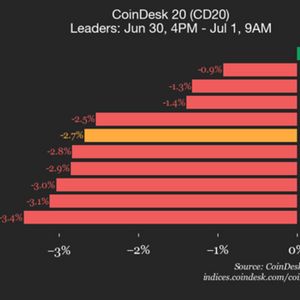Coinbase: On Path To Dominate Institutional Crypto
6 min read
Summary Coinbase’s profitability surge is underpinned by secular crypto tailwinds and a shift to high-margin, recurring revenue streams beyond trading. Dominance in ETF custody, rapid Base adoption, and USDC/derivatives growth anchor predictable, diversified revenue, reducing reliance on volatile retail trading. Financials are robust: a fortress balance sheet, expanding margins, and recurring revenues now cover fixed costs regardless of crypto market cycles. Despite regulatory and competitive risks, COIN is undervalued; I project 73% upside over 12 months as durable cash flow flywheels accelerate. Introduction Coinbase Global’s ( COIN ) break back into profitability in the March quarter arrived just as a constellation of secular growth catalysts finally aligned: Bitcoin pierced six figures, the U-S approved spot crypto ETFs , and Congress moved the first comprehensive stable-coin bill out of committee. Against that backdrop, the exchange delivered $2.0 billion in revenue , $66 million in net income and a muscular $930 million of adjusted EBITDA, its best operating print since 2021. The share price responded by vaulting 106% year-to-date , the single best return in the S&P 500 through the second quarter. Yet, a closer read of the numbers suggests the rally has only started: the company is no longer merely a cyclical trading venue but is fast becoming the default operating system for on-chain finance. Visual from Coinbase’s investor hub summarizing its multi-product crypto platform (Coinbase) Thesis Coinbase is methodically layering high-margin, recurring businesses on top of its core spot exchange. Custody now safeguards 81% of the $140 billion parked in U-S crypto ETFs, while Base (its Ethereum Layer-2) already sits near the top of L2 throughput tables and underpins a USDC payment rail that Shopify is rolling out to millions of merchants. USDC reserve interest and a 6 200% year-to-date surge in international derivatives volume are broadening the revenue mix. With the SEC lawsuit dismissed and legislative momentum turning constructive, Coinbase is positioned to monetize every major growth vector in digital assets. The flywheels are spinning together: more on-chain activity feeds Base, which deepens custody relationships, which in turn channels institutional flow back to the exchange. Custody Dominance Anchors Institutional Trust Institutional managers embraced Coinbase as the backbone of their ETF plumbing as soon as the first spot Bitcoin and Ether products launched. By mid-2025 those funds held roughly $140 billion in assets, and Coinbase’s custody arm controlled 81% of that trove, dwarfing the next closest competitor. This concentration of trust has practical consequences: incremental ETF inflows translate almost directly into predictable fee revenue, insulating earnings from the volatility of retail trading. The custody franchise also creates formidable switching costs; an issuer who has already completed operational due diligence, SOC2 audits and wallet integrations is unlikely to migrate assets elsewhere. The balance-sheet impact is equally powerful. Average assets under custody climbed to $212 billion in Q1, up $25 billion sequentially. While pure custody fees are now reported inside “Other subscription and services,” those fees flow with negligible expense drag, lifting consolidated gross margin above 80% for that revenue bucket. Because custodial users tend to adopt Prime brokerage and derivatives products, the custody moat is seeding future cross-sell opportunities that should continue to widen Coinbase’s lifetime value per institutional client. Portfolio overview inside Coinbase Custody showing vault balances (Coinbase) Base Turns Coinbase Into an On-Chain Tollbooth Launched only last year, Base has leap-frogged older rollups to capture the lion’s share of L2 activity fees in 2025 (roughly 67% according to Messari). Daily transactions spiked past 9 million, a record for any Ethereum scaler to date. Crucially, Base is not just a throughput story; it is the substrate for Coinbase’s push into payments and commerce. That strategy crystallised in June when Shopify enabled merchants to accept USDC on Base directly through Shopify Payments, with no extra gateways or blockchain setup required. The integration drops settlement costs to roughly 0.1% and offers sub-second finality, an order-of-magnitude improvement over card rails. Coinbase captures fees every time a transaction hits the rollup, collects a share of the float on USDC held in wallets, and deepens the network effects of its developer stack. As more commerce moves on-chain, the company earns a structural “toll” that is uncorrelated with trading volumes. Coinbase research chart showing surging on-chain protocol usage over 2024-25 (Coinbase) Recurring Revenue Flywheels: USDC Yield and Derivatives Subscription and services revenue reached $698 million in Q1, 36% of net revenue and up 9% sequentially. The single biggest contributor was the interest Coinbase earns on USDC reserves. Under its revised agreement with Circle, the exchange keeps 100% of the interest on USDC that sits on its own platform and 50% of the residual reserve income on external balances. With circulating USDC topping $60 billion and Coinbase-controlled balances up 49% quarter-over-quarter to $12.3 billion, this annuity stream is scaling quickly even in a moderating rate environment. On the trading side, derivatives are the fastest-growing wedge. Coinbase International Exchange expanded perpetual listings from 15 to 106 within a year, driving a 6200% jump in average daily volume. Q1 global derivatives turnover hit $804 billion, compared with $393 billion of spot volume. Derivatives carry structurally lower unit economics than spot but are far less volatile, and management’s decision to sacrifice fee rate through maker rebates is a rational land-grab that will pay dividends once incentives normalize. The pending $2.9 billion purchase of options powerhouse Deribit promises to add yet another high-margin leg to this wheel. Financials Revenue of $2.034 billion fell 10% sequentially but remains up 25% from the year-earlier quarter. Transaction revenue accounted for $1.262 billion and subscriptions $698 million, the latter delivering an 86% gross margin. Adjusted EBITDA margin expanded to 47% versus 43% in Q4 as operating expenses were held flat on a constant-currency basis. The balance sheet is fortress-like: $9.9 billion of USD resources plus $1.3 billion of investment crypto assets give Coinbase $11.8 billion in total liquidity. Net cash stands at roughly $5.8 billion after backing out the $4.1 billion of senior notes, implying ample capacity to fund the Deribit acquisition without equity dilution. Free cash flow was positive for the fourth consecutive quarter and exceeded GAAP net income by a factor of six, reflecting heavy non-cash charges and working-capital inflows tied to USDC growth. Management’s Q2 guide calls for subscription revenue of $600-$680 million and OPEX of $700-$750 million, implying another profitable quarter even if spot volumes retrace to April’s run-rate. The key takeaway is that the firm no longer needs bull-market trading activity to cover its fixed cost base; recurring lines already shoulder that burden. Coinbase Quarterly Financials (Coinbase) Risks Regulatory overhang has abated but not disappeared. While the SEC lawsuit’s dismissal removes an existential threat, stable-coin and staking rules remain in flux and could constrain two of Coinbase’s fastest-growing businesses. Political winds can shift after the U-S election, and any reversal of the draft stable-coin framework could pressure USDC economics. Competition is intensifying. Binance regained partial access to U-S users through a partnership with MoonPay, and traditional exchanges such as CME are preparing to list their own crypto perpetuals. Fee compression is inevitable as these incumbents chase volume with maker rebates similar to Coinbase’s. Finally, crypto markets remain cyclical; a prolonged risk-off spell would still dent spot and derivative volumes, testing management’s discipline on expense growth. Conclusion At $369 a share, Coinbase commands a market capitalization of roughly $90 billion and an enterprise value of $84 billion. Using the trailing twelve-month adjusted EBITDA of $4.28 billion, the stock trades at 20× EV/EBITDA, 61× forward earnings and 13.9× sales. Robinhood commands 56× forward earnings and an even richer 23× sales multiple, despite far lower margins and no custody franchise. CME Group, by contrast, trades at 25× forward earnings and 15.7× sales but delivers mid-30% EBITDA margins versus Coinbase’s mid-40s. On a growth-adjusted basis, the crypto exchange is cheaper: consensus models call for 45% compound EPS growth through 2027, placing Coinbase’s PEG near 1.3 versus Robinhood’s unquantifiable multiple and CME’s 2.4. The market is still valuing Coinbase mostly as a high-beta proxy for Bitcoin. That overlooks a maturing business that now collects predictable rent from custody, stable-coin float, expanding derivatives complex and the Base application economy. As those flywheels accelerate, EBITDA should compound faster than reported revenue, compressing today’s 20× multiple into the low-teens by 2027 even without heroic top-line assumptions. My twelve-month base case assigns a 25× forward EBITDA multiple to a conservatively modeled $6.0 billion of 2026 EBITDA, yielding a $150 billion enterprise value and a $640 share price (73% upside from current levels). In short, the stock remains undervalued relative to the durability and diversity of its cash flows, and I remain firmly bullish.

Source: Seeking Alpha



